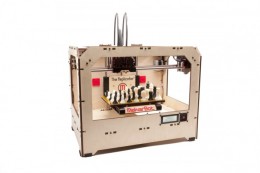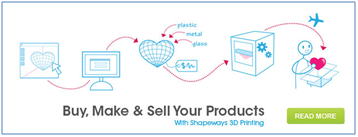The Rise of 3D Printing in Creative Culture. By Karen Marsh, Business Development Manager, ANAT, Oct 2011
“Transformative change happens when industries democratize, when they’re ripped from the sole domain of companies, governments, and other institutions and handed over to regular folks. The Internet democratized publishing, broadcasting, and communications, and the consequence was a massive increase in the range of both participation and participants in everything digital — the long tail of bits. Now the same is happening to manufacturing — the long tail of things.” Chris Anderson, Wired (1)
The “next industrial revolution” is rapidly heading our way. Digital technologies are transforming the way new products are designed, manufactured, marketed and distributed. A radical shift in manufacturing is taking place, one that takes control away from the traditional manufacturers and places it into the hands of the creators themselves. The rapidly evolving fields of personal fabrication, digital manufacturing and 3D printing are beginning to do to manufacturing what the internet has done to information-based goods and services – and will ultimately have the power to transform creative culture.
These developments are being driven by creative people. In garages, workshops, studios and backyards around the world, artists, craftspeople, hobbyists and inventors are designing and making things, their creativity empowered by a proliferation of user generated, open source and easy to use tools that are now freely available online. The explosion of DIY creativity that started out with simple propositions such as selling hand-crafted products on Etsy, now extends to complex platforms such as the trailblazing Arduino electronics hardware project that allows creators to integrate intricate electronics into their works.
A number of converging forces are enabling this situation to arise. Web-based developments including increased online collaboration and the growth of open source software, combined with the plummeting cost personal fabrication machines such as 3D printers and laser-cutting devices (‘fabbers’), are driving the crossover of these technologies from the fringes into mainstream culture. The US Government has recently taken note. In 2010, the Office of Science and Technology Policy commissioned Cornell University to investigate these technologies, in a report entitled “Factory @ Home: The Emerging Economy of Personal Fabrication”. In the words of this report:
“These technologies remove the barriers of investment in heavy machinery and specialized operator skill, so consumers, for the first time since the era of artisan craft production, will lead the design and manufacturing process.” (2)
One only needs to look at the online marketplace of personal fabrication service Shapeways (tagline: “passionate about creating”) to view this cultural revolution in progress. The Shapeways Shop provides innumerable examples of unique new products and artworks, designed by inventors, artists and hobbyists from around the world. See for example Dutch kinetic artist Theo Jansen’s Strandbeests – a tiny but fully-functional version of this incredibly complex artwork is available through the artist’s own Shapeways shop, enabling the artist to develop a sustainable business from sale of his artworks.
Services such as Shapeways make it easy for creative practitioners to sell their work. The process is simple – design a product in 3D using a free online tool such as Google’s Sketchup, upload the designs, then allow Shapeways to take care of the rest, including prototyping, manufacturing, marketing, and selling the product. All the artist needs to decide is how much mark-up to charge. They can even allow others to customise their designs through the ‘Co-creator Platform’. Materials that can be used include ceramic, glass, stainless steel, and silver.
For a completely DIY approach, the advent of the desktop 3D printer is now enabling creators to manufacture their designs themselves, in their own homes and workplaces. For example, Makerbot Industries now sell their ‘Thing-O-Matic’ 3D printer for just US$1300. This is in effect “a little high-production factory that sits on your desktop” (3). Five years ago, a machine with these capabilities would have cost upwards of $100k. Small quantities of raw materials can now be sourced through Inventables, and an incredible range of components and parts through Alibaba. Once products have been made, setting up one’s own ecommerce shop is now relatively simple and cheap through merchants such as Yahoo or Bigcommerce.
The effect of these technologies on the speed of innovation is incredible – a new product can now be conceived of, designed, prototyped, manufactured and sold within a matter of days.
All this is happening right now, in garages, workshops and shared community spaces around the world. But what of the future? In the words of Cornell University:
“Within a few years, personal manufacturing technologies will be commonplace in small businesses and schools. Within a decade or two, every household and office will own their own machine. Within a generation, you will have a hard time explaining to your grandchildren how you were able to live without your own fabber, when you actually had to buy ready made things online, and wait a long 24 hours before they showed up in your mailbox” (2)
An even broader vision was described at a recent TED talk by Neil Gershenfeld from MIT’s Center for Bits and Atoms. Gershenfeld’s pioneering work has lead to the worldwide network of ‘Fab Labs’. In these personal fabrication centres, people are given access to equipment that enables them to work on solutions to local problems – from agricultural instruments in India to steam turbines for energy conversion in Ghana. He envisions a future in which people in developing nations are able to download free electronic blueprints to make the products that their specific community needs, from prosthetic limbs to electronics. In his words, the real future opportunity is “to harness the inventive power of the world to locally design and produce solutions to local problems.” (4)
How can Australia become part of this revolution?
Visionary government support is required to enable Australia to fully realise the potential benefits of these technologies. It is recommended that immediate support is provided to support creative practitioners, researchers, community groups and innovative businesses to integrate personal fabrication technologies into their workplaces, education programs and creative practices.
Recommendations:
1.Pilot Programs – Allocate support for pilot programs to disseminate information and provide training in the processes and technologies involved in digital manufacturing.
2.Establish an Australian ‘Fab Lab’ – Provide funding to purchase the equipment needed to establish Australia’s first Fab Lab, to enable people to trial these technologies for themselves. This could be in a fixed location, however a ‘Mobile Fab Lab’ (a portable computer-controlled design and machining shop) would enable information to be disseminated across Australia through a national touring program.
3.Education – In the longer-term, it is recommended that small scale personal manufacturing labs are established in research institutions, higher education facilities and schools across Australia, and training is provided for educators in design and manufacturing technologies.
Benefits:
The benefits of supporting these technologies in Australia are deep, far-reaching, and long-term. They include:
• Supports Australian innovation, commercialisation and new product development
• Directly addresses issues of local manufacturing industry decline with an alternative that will ultimately be accessible to businesses of all sizes, and that decreases reliance on major manufacturing economies such as China
• Products can be manufactured locally, with only the digital designs needing to be distributed around the world, so eliminating the carbon footprint of manufactured goods
• Products can be printed on-demand, without the need for inventory to be held in stock
• Whole products can be printed out in one process, reducing the need for assembly lines
• Products can be customised to better meet the needs of the end consumer
• Small businesses, and even individual consumers, can manufacture simple items in their own homes and workplaces
• Integrates creativity into industrial processes, hence supporting the transition from a process-driven to a creative, knowledge-driven economy
• Connects government with grassroots, community activity
By providing support for the development of these emerging technologies, Australia can truly position itself at the forefront of this new industrial revolution.
“The industrial revolution fundamentally transformed the social, economic and political landscapes, by transforming the nature of production, labor and wealth. The digital revolution restructured human interaction, innovation and opportunities. Personal Manufacturing will leverage the power behind both revolutions to fundamentally restructure the economic, political and social structures of the world” – Jeffrey Lipton, Cornell University (2)
References:
[1] Chris Anderson, Wired Magazine “In the Next Industrial Revolution, Atoms Are the New Bits” http://www.wired.com/magazine/2010/01/ff_newrevolution/2/
[2] “Factory @ Home: The Emerging Economy of Personal Fabrication”
[3] www.makerbot.com
[4] http://www.ted.com/talks/neil_gershenfeld_on_fab_labs.html


